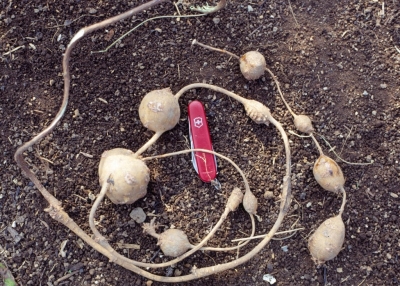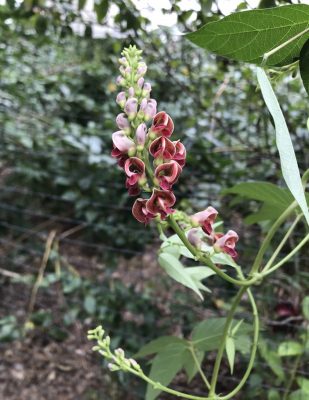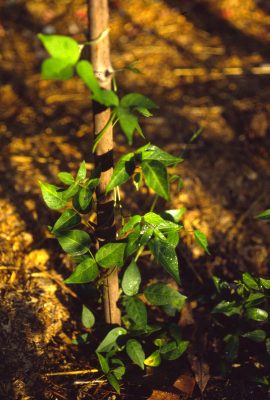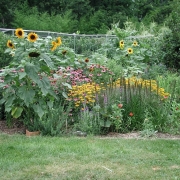ONE OF THANKSGIVING’S UNSUNG HEROES
Years ago I wrote about one of the unsung heroes of Thanksgiving, the groundnut (Apios americanum). This plant, which helped nourish the Pilgrims through their first winters, never achieved the reknown of corn, pumpkins, cranberries, and other foods of the season.

When I first wrote about groundnuts, I had just planted them. I pointed out that there was renewed interest in the plant, though specifics as to how to grow it were wanting and selection of superior clones was just beginning. Now that I have grown groundnut for a few (thirty plus!) years, I am ready to share my experiences.
It Looks Like . . . And Acts Like . . .
As you might guess from the name, the plant makes edible tubers, usually the size of golfballs and strung together on a thinner, ropelike root. The swollen roots on one of my plants are more the size of tennis balls than golf balls. Not as obvious, below ground, at least, is that the plant is a legume; as such, it can “fix” atmospheric nitrogen, that is, put it in a plant-available form.
The plant also has shown some virtues aboveground. Chocolatey brown flowers dangle like jewelry from the twining stems. The flowers are pretty enough to have accorded groundnut a place in flower gardens in France a hundred years ago. On some plants, the flowers also have a strong and delicious aroma – vanilla, instead of chocolate, though.

I started some of my plants from seed; others I purchased growing in pots. I trained each vine up and down and around a tomato cage. The plants were and still are in full sun and rich soil, with a thick mulch of wood chips. The ground is so fluffy that I can harvest by just grabbing one end of a root, then pulling it up and out of the soil.
Soon after I planted groundnut, I discovered that it is weedy. I was soon finding plants, first sneaking across the ground a couple of feet from mother plants, and then further and further.
Aboveground, the twining stems reached around and insinuated themselves amongst the branches of a nearby bush cherries and other plants.

To further unsettle me, I was startled at the reappearance, with vigor, of one young plant which I thought I had destroyed as I dug looking for edible roots. (I since learned that harvest must be delayed until the second season.) I hope groundnut will not prove to be as unruly and as hard to remove as the horseradish I once foolishly planted in the garden!
Is It Good To Eat?
Now for the important question: What does groundnut taste like? Thomas Hariot, in A briefe and true report of the new found land of Virginia (1590) may have been the first to write of groundnut, and his opinion was “boiled or sodden they are very good meate.” In 1602, a correspondent from New England wrote to Sir Walter Raleigh that groundnuts were “as good as potatoes.”
Dr. E. Lewis Sturtevant (Sturtevant’s Notes on Edible Plants, 1919) reported an eighteenth century horticulturalist writing that the “Swedes ate them for want of bread, and that in 1749 some of the English ate them instead of potatoes.” He also quotes a nineteenth century writer, who wrote that the Pilgrims “were enforced to live on ground nuts.”
Moving up to the twentieth century, wild food forager Euell Gibbons, who enjoyed everything from cattails to milkweed pods, was reserved in his praise of groundnuts.
I have harvested groundnuts and, because they should not be consumed raw, boiled some and baked some. They taste almost as good as potatoes, though less distinctive. The texture was dry and mealy. Like Euell, I am reserved in my praise of the roots, though other groundnut plants might have better or worse roots. (After all, not all potatoes taste the same.)
I do think that groundnut, even in its present primitive state, is a native, perennial, permaculture friendly vegetable (I have been accused by some of being a permaculturalist) good enough to deserve a place at the Thanksgiving table. That is, it deserves a place in the garden and on the Thanksgiving table as long as it’s planted where its growth and spread can be reined in.
How about calling it one of its Indian names – nu nu, perhaps – and making nu nu stuffing standard Thanksgiving fare? Happy Thanksgiving!



I have tried milkweed pods. They were good boiled with a little butter and salt. Harvest them when small, before they make the fluffy stuff inside, however.
I’ve heard of eating them but, in all honesty, the idea doesn’t appeal to me at all. Butter and salt could make a lot of things taste good. But perhaps I’m missing out on a delicious and nutritious food.
Hi Lee,
Adele Warshawsky here. Although I am not a gardener, I truly enjoy reading your posts and learning something new in each one. I want to wish you and Debbie a very healthy, awesome day today and hope that someday we will meet again.
Yes Adelle, that would be very nice.
Lee, do you have a source for this plant? I’d grow it in large containers just for those amazing flowers.
Just search for Apios americana on the web. I just saw a few ebay listings and I’m sure there are others. Iowa State University has a collection of different clones.
I have occasionally thought of planting these. I never did because I wasn’t sure they would taste good enough to be worth the effort of digging and cleaning them. I’ll trust your taste buds that they’re pretty good. Do you harvest them in the second year to let the tubers size up or is there another reason? Can you replant the smaller tubers (like with potatoes)? Love your work.
Yes, tubers will get larger their second year. I’m sure you can replant small tubers. Propagating the plant is no problem, to say the least!
Ha! Being called a permaculturist is a compliment! Then again, I was once accused of having a living room that looked “like the inside of a g********d greenhouse”, to which I responded delightedly “Why, thank you!”
Our attempt at growing groundnuts suffered for want of sun on a small shady lot. This piece might encourage us to try again.
Wow, My ground nuts never got this big! I grow mine for the flowers, scent, and pleasing leaves, only eating tubers torn out when they grow too far out of bounds. As you say butter, salt and garlic does wonders at the table. Did you know that these vines hate cedar and will grow away from cedar fences, against the light, rather than touch the wood? The cedar oil fumes? Yet accept juglone! I love your posts. Renée, Ottawa, Ontario
Thanks for the tip about cedar and ground nuts. I’ll now feel more relaxed about growing it.
Apios Americanum! So that is probably the persistent wild vine that I’ve been trying to eliminate from my garden! Maybe I should instead cultivate it in a raised bed for containment? I’ll need positive identification first. I used to just taste or sample wild plants to see if I liked them.
Beware, don’t do that! This fall, I burned off a patch of raspberries gone wild to salvage roots and replant raspberries. I came across a root that looked similar to parsnip. I thought it might be QueenAnns Lace or Burdock. I chewed a chunk of the root tip to see what it tasted like, and (huge mistake) swallowed. Apparently it was poison Hemlock, and I literally almost died. I say never sample unknown wild plants!
Wow. You are lucky. Poison hemlock is extremely poisonous!
I have these growing near my house and they grow along the sandy river in Maine. Where the sandy river meets the Kennebec river was the site of a giant native american encampent and the native americans propataged ground nuts in many areas.
Last May I paddled the sandy river in my canoe a few days after there had been flooding in the area. The rapids where very treacherous and I capsized in a big rapid. This has not happened to me in a long time. Further downstream however I found that the flooding had washed the groundnuts out onto the sandbars and there was groundnut tubers all over the place
Lucky you, to have access to the tubers without risking planting them in and having them take over your garden.